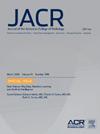放射学中的远程套利:作为一种适应不断变化的实践需求的专业的多种隶属关系。
IF 5.1
3区 医学
Q1 RADIOLOGY, NUCLEAR MEDICINE & MEDICAL IMAGING
引用次数: 0
摘要
目的:分析2017年至2024年医疗保险服务医师团体和州附属机构数量的趋势,重点是诊断放射科医师。方法:从CMS医师和其他供应商公共使用档案(2017-2024)中获取隶属关系数据。小组和国家的每位医生的隶属关系进行了跨专业分析,并在诊断放射科医生和非放射科医生之间进行了比较。统计分析包括描述性测量、复合年增长率(CAGR)、t检验、相关性、混合效应模型和回归模型。还进行了亚组和代际分析。结果:从2017-2024年,635,961名独特的医生被纳入该分析。所有的医生平均有1.19个团体和1.06个州的隶属关系。在医生专业中,诊断放射科医生的平均隶属关系数量最高,平均有2.03个团体和1.31个州。这分别是所有非放射科医师的1.7倍和1.2倍。从2017年到2024年,每个非放射科医生的隶属关系的复合年增长率在群体中为-0.12%,在州中为+0.14%,而在诊断放射科医生中,群体为+2.23%,在州中为+1.63%。结论:与所有其他类型的医生相比,诊断放射科医生更有可能通过使用多个团体和国家附属机构来扩大他们的服务范围。尽管最近的技术和政策进步有可能通过使用跨群体和州的联盟来扩大获得护理的机会,但在其他类型的医生中,这些策略的使用并不多。本文章由计算机程序翻译,如有差异,请以英文原文为准。
Remote Arbitrage in Radiology: Multiple Affiliations as a Specialty Specific Adaptation to Changing Practice Demands
Objective
To analyze trends from 2017 to 2024 in the number of group and state affiliations among Medicare-serving physicians, with emphasis on diagnostic radiologists.
Methods
Affiliation data were obtained from the CMS Physician and Other Supplier Public Use File (2017-2024). Group and state affiliations per physician were analyzed across specialties and compared between diagnostic radiologists and nonradiologist physicians. Statistical analyses included descriptive measures, compound annual growth rates, t tests, correlation, mixed-effect models, and regression models. Subgroup and generational analyses were also conducted.
Results
From 2017 to 2024, 635,961 unique physicians were included in this analysis. All physicians had an average of 1.19 group and 1.06 state affiliations. Among physician specialties, diagnostic radiologists had the highest average number of affiliations, with 2.03 groups and 1.31 states on average. This is 1.7 and 1.2 times as many affiliations, respectively, compared with all nonradiologist physicians. From 2017 to 2024, the compound annual growth rates of affiliations per nonradiologist physician was −0.12% for groups and +0.14% for states, whereas for diagnostic radiologists it was +2.23% for groups and +1.63% for states.
Conclusions
Compared with all other types of physicians, diagnostic radiologists are much more likely to expand the reach of their services through use of multiple group and state affiliations. Despite recent technological and policy advances with the potential to expand access to care through use of affiliations across groups and states, there has only been modest use of these strategies among other physician types.
求助全文
通过发布文献求助,成功后即可免费获取论文全文。
去求助
来源期刊

Journal of the American College of Radiology
RADIOLOGY, NUCLEAR MEDICINE & MEDICAL IMAGING-
CiteScore
6.30
自引率
8.90%
发文量
312
审稿时长
34 days
期刊介绍:
The official journal of the American College of Radiology, JACR informs its readers of timely, pertinent, and important topics affecting the practice of diagnostic radiologists, interventional radiologists, medical physicists, and radiation oncologists. In so doing, JACR improves their practices and helps optimize their role in the health care system. By providing a forum for informative, well-written articles on health policy, clinical practice, practice management, data science, and education, JACR engages readers in a dialogue that ultimately benefits patient care.
 求助内容:
求助内容: 应助结果提醒方式:
应助结果提醒方式:


